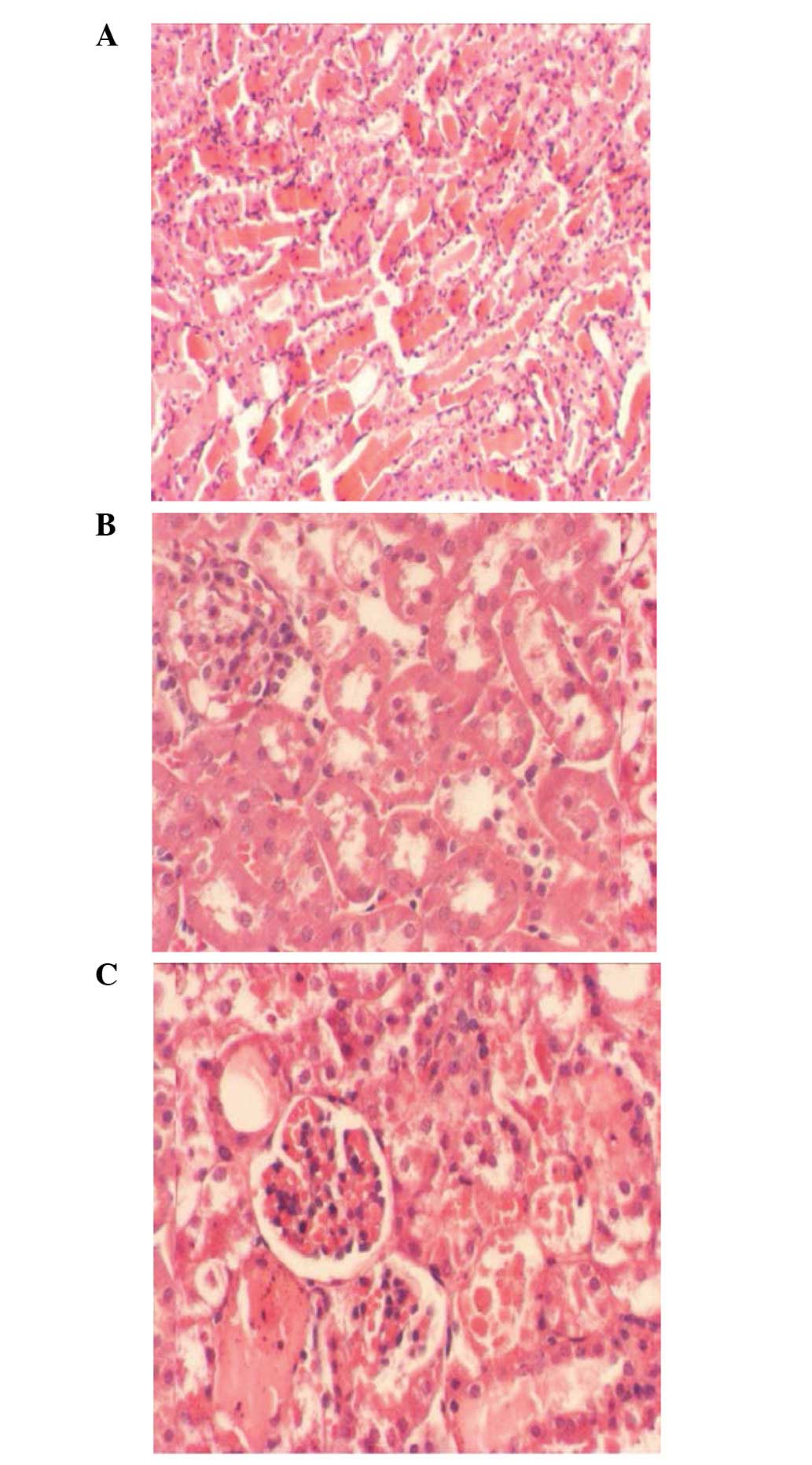Renoprotective activity of sivelestat in severe acute pancreatitis in rats
- Authors:
- Houhong Wang
- A-Mao Tang
- Daren Liu
- Guogang Li
- Longyun Ye
- Xiaowen Li
- Chao Li
- Li Chen
-
View Affiliations
Affiliations: Department of Surgery, Zhejiang University School of Medicine, Second Affiliated Hospital, Hangzhou, Zhejiang 310009, P.R. China, Zhejiang University of Traditional Chinese Medicine, Hangzhou, Zhejiang 310053, P.R. China
- Published online on: April 24, 2013 https://doi.org/10.3892/etm.2013.1075
-
Pages:
29-32
Abstract
Acute pancreatitis, affecting 382,014 individuals annually in China, is life-threatening in its severe form. Since acute pancreatitis-associated morbidity or mortality is attributable mainly to functional failure of the vital organs, significant research efforts have focused on the identification of novel agents with potential organ-protective properties in the hope of developing approaches to improve the outcome of acute pancreatitis. In a previous study, we demonstrated that sivelestat, a specific inhibitor of neutrophil elastase (NE), is effective in protecting against lung failure in rats with taurocholate-induced acute pancreatitis. As part of the analyses extended from that study, the present study aimed to evaluate the role of sivelestat in the protection against acute pancreatitis-associated renal injury. Renal histopathology and major renal function parameters were analyzed in renal tissue and blood specimens collected from rats with acute pancreatitis induced by the surgical administration of sodium taurocholate in the presence or absence of sivelestat treatment and in sham-operated control rats at various time‑points. The extended analyses demonstrated that: i) sodium taurocholate induced apparent renal injury and dysfunction manifested by histological anomalies, including vacuolization and apoptosis of the cells of the tubular epithelial lining in the kidney, as well as biochemical aberrations in the blood (increases in levels of blood urea nitrogen, creatinine and tumor necrosis factor-α) and renal tissue (robust increases in NE activity and induced neutrophil chemoattractant-1 levels); and ii) sivelestat treatment effectively attenuated all taurocholate-induced histological anomalies and biochemical aberrations. These observations strongly suggest that the NE inhibitor, sivelestat, is effective in protecting against acute pancreatitis-associated renal injury.
View References
|
1.
|
Khan AS and Latif SU: Controversies in the
etiologies of acute pancreatitis. JOP. 11:545–552. 2010.PubMed/NCBI
|
|
2.
|
Harper SJ and Cheslyn-Curtis S: Acute
pancreatitis. Ann Clin Biochem. 48:23–37. 2011. View Article : Google Scholar
|
|
3.
|
http://www.rightdiagnosis.com/a/acute_pancreatitis/stats-country.htmuri.
|
|
4.
|
Bradley EL: A clinically based
classification system for acute pancreatitis. Summary of the
International Symposium on Acute Pancreatitis, Atlanta, Ga,
September 11 through 13, 1992. Arch Surg. 128:586–590. 1993.
View Article : Google Scholar : PubMed/NCBI
|
|
5.
|
Talukdar R and Vege SS: Recent
developments in acute pancreatitis. Clin Gastroenterol Hepatol.
7:S3–S9. 2009. View Article : Google Scholar
|
|
6.
|
Waldthaler A and Schütte K: Causes and
mechanisms in acute pancreatitis. Dig Dis. 28:364–372. 2010.
View Article : Google Scholar : PubMed/NCBI
|
|
7.
|
Greer SE and Burchard MW: Acute
pancreatitis and critical illness: a pancreatic tale of
hypoperfusion and inflammation. Chest. 136:1413–1419. 1993.
View Article : Google Scholar : PubMed/NCBI
|
|
8.
|
Kawabata K and Suzuki M: ONO-5046, a novel
inhibitor of human neutrophil elastase. Biochem Biophys Res Commun.
177:814–820. 1991. View Article : Google Scholar : PubMed/NCBI
|
|
9.
|
Wang HH, Tang AM, Chen L and Zhou MT:
Potential of sivelestat in protection against severe acute
pancreatitis-associated lung injury in rats. Exp Lung Res.
38:445–452. 2012. View Article : Google Scholar : PubMed/NCBI
|
|
10.
|
Banks PA and Vege SS: Classification of
acute pancreatitis - 2012: revision of the Atlanta classification
and definitions by international consensus. Gut. 62:102–111. 2013.
View Article : Google Scholar : PubMed/NCBI
|
|
11.
|
Vege SS, Gardner TB, Chari ST, Munukuti P,
Pearson RK, Clain JE, Petersen BT, Baron TH, Farnell MB and Sarr
MG: Low mortality and high morbidity in severe acute pancreatitis
without organ failure: a case for revising the Atlanta
classification to include “moderately severe acute pancreatitis”.
Am J Gastroenterol. 104:710–715. 2009.PubMed/NCBI
|
|
12.
|
Kudari A, Wig JD, Kim V, Kochhar R,
Majumdar S, Gupta R, Yadav DT and Doley RP: Histopathological
sequential changes in sodium taurocholate-induced acute
pancreatitis. J Pancreas. 8:564–572. 2007.PubMed/NCBI
|
|
13.
|
Kumasaka R, Nakamura N, Fujita T, Murakami
R, Shimada M, Osawa H, Yamabe H and Okumura K: Beneficial effect of
neutrophil elastase inhibitor on anti-Thy1.1 nephritis in rats.
Nephrology. 13:27–32. 2008.PubMed/NCBI
|












